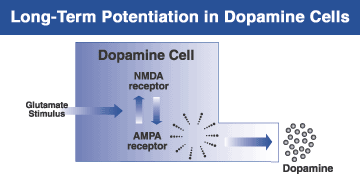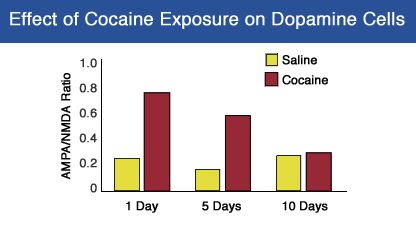|
 When the brain chemical glutamate reaches dopamine cells in the ventral tegmental area, it activates specific sites called NMDA receptors and AMPA receptors. Electrical current generated by the AMPA receptors triggers the release of dopamine, a chemical associated with the pleasurable effects of addictive drugs. Release of dopamine is enhanced by a condition called long-term potentiation (LTP), which is thought to play a role in associative learning and memory formation. When LTP has been established a glutamate stimulus results in higher AMPA currents; therefore, the cell is likely to release dopamine more abundantly than it would have previously. NIDA-supported researchers have found that a single exposure to cocaine can establish LTP in mice, and that the enhanced activity lasts for more than 5 days. |
NIDA-supported research has identified a neurobiological mechanism that could be involved in initiating the compulsive drug-seeking behavior that is the behavioral hallmark of cocaine addiction. Scientists have shown that, in mice, a single exposure to cocaine induces changes in brain cells that are very similar to long-term potentiation, a process that plays an important role in associating experiences with feelings and motivation.
When a stimulus induces long-term potentiation in a cell, the cell will respond more strongly to future exposures to the same stimulus. Using mice, Dr. Robert Malenka of Stanford University in Palo Alto, California, along with Dr. Antonello Bonci and his colleagues at the University of California, San Francisco, showed that cocaine induces this effect on dopamine (DA) cells in the brain's ventral tegmental area (VTA). When stimulated by cocaine, these mouse cells release the neurotransmitter DA, a brain chemical that leads to feelings of pleasure. By increasing the responsiveness of the VTA DA cells, cocaine-induced potentiation could create powerful associations between drug taking, the situations in which drugs are taken, and feelings of pleasure.
To assess the effect of cocaine, Drs. Malenka and Bonci measured the electrical currents generated in VTA DA cells by activation of structures known as AMPA receptors-sites that, along with NMDA receptors respond to another neurotransmitter, glutamate. In general, the more current that flows through a cell's AMPA receptors, the more DA the cell will release. The researchers showed that exposure to a dose of cocaine (15 mg/kg of body weight) comparable to doses used by humans caused a higher current to flow through AMPA receptors; consequently the VTA neurons would be expected to release DA more abundantly.
"A single injection of cocaine more than doubles the activation of the dopamine cells. The changes were still present 5 days later, but not 10 days after injection," Dr. Malenka says. "This finding alone does not explain cocaine's ability to produce compulsive drug-seeking behavior. But for the first time it describes how cocaine can trigger a mechanism that contributes a small but important part of the complex cascade of events that leads to addiction."
 Mice injected with a single dose of cocaine exhibited a higher ratio of AMPA to NMDA currents - an indication of long-term potentiation - in dopamine cells in the ventral tegmental region 1 day and 5 days after the drug exposure. Mice injected with saline showed no long-term potentiation. |
"Two aspects of this study have particular significance," says Dr. Susan Volman of NIDA's Division of Neuroscience and Behavioral Research. "First, the effect was obtained with a single dose of cocaine. Second, the effects of cocaine were indistinguishable from long-term potentiation, which suggests that, for nearly a week after it is administered, cocaine utilizes the cellular mechanism involved in normal adaptive learning." By forging associations between experiences and positive or negative feelings, long-term potentiation of DA and other types of brain cells is a key mechanism in learning and memory and, in this way, has an impact on future behavior.
Source
Ungless, M.A.; Whistler, J.L.; Malenka, R.C.; and Bonci, A. Single cocaine exposure in vivo induces long-term potentiation in dopamine neurons. Nature 411:583-587, 2001. [Abstract and Full Text]
|